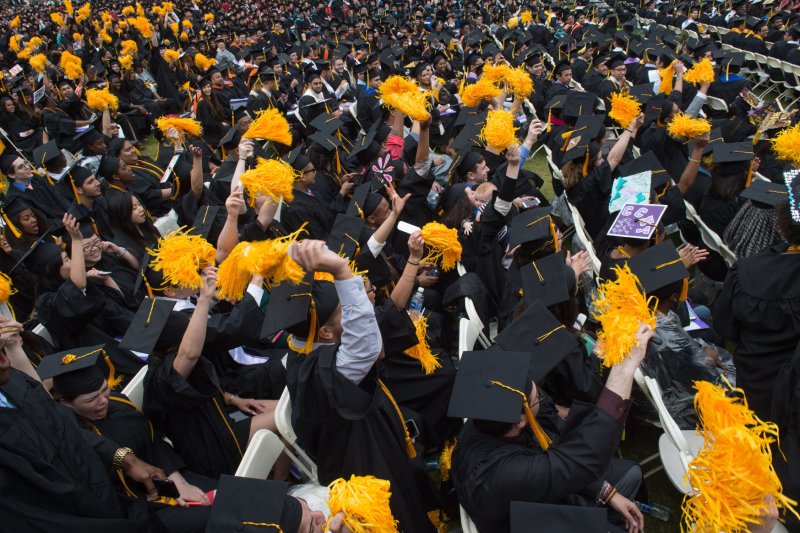The think tank correlated rising tuition with a significant decrease in per-student funding in all 50 states over a 10-year period. File Photo by Bryan R. Smith/UPI |
License Photo
Oct. 25 (UPI) -- Decreases in state funding have pushed the cost of higher education to historic levels over the past decade, according to a new report by a budgetary think tank.
The 22-page analysis by the Center on Budget and Policy Priorities said Thursday the average cost for tuition at four-year public institutions in all 50 states increased by nearly 40 percent between 2008 and 2018, or a little over $2,700. Overall funding for two- and four-year state colleges and universities, meanwhile, decreased by $6.6 billion.
The increases have translated into some of the highest tuition costs in history.
Researchers said the fact that the rise began at the time of the U.S. financial crisis is no coincidence.
"Many states closed revenue shortfalls after the recession and its subsequent sluggish recovery through sizable budget cuts, as opposed to pursuing a more balanced mix of responsible and targeted cuts and revenue increases," the report states.
"In fact, between fiscal years 2008 and 2012, for every $1 state lawmakers raised in new revenue they cut $3 from existing spending."
Over the 10-year period, 41 states spent less per student -- on average, 13 percent less. Six states -- Alabama, Arizona, Louisiana, Mississippi, Oklahoma and Pennsylvania -- cut per-student funding by more than 30 percent. The reductions had a direct impact on the rising education costs, the CBPP analysis said.
Tuition at four-year schools in Louisiana doubled and seven states -- Alabama, Arizona, California, Colorado, Florida,Georgia, and Hawaii -- raised the cost of attendance by more than 60 percent.
"These sharp tuition increases have accelerated longer-term trends of college becoming less affordable and costs shifting from states to students," the study says. "Over the last 20 years, the price of attending a four-year public college or university has grown significantly faster than the median income."
Although federal student aid has risen to offset some of the increase, the center noted, it has fallen short of covering the overall cost of attendance.
The net cost of attending higher education at public four-year institutions -- that is, the price of published tuition and fees, room and board, books and supplies subtracted from the average aid a student receives -- climbed by nearly $3,000 per U.S. student over the 10-year span.
The report said that amid the rising costs is $1.6 trillion American students owe in student debt, and a conclusion that higher education may now be less affordable now than it's been in years.
"Rising tuition threatens affordability and access, leaving many students and their families -- including those whose annual wages have stagnated or fallen over recent decades -- either saddled with onerous debt or unable to afford college altogether," the researchers wrote.
The rising costs, the CBPP noted, also hinder the ability of students of color and low-income families to secure educational loans.
"Even with access to Pell grants and state or institutional aid, low-income students are much more likely than their high-income counterparts to borrow to pay for college," it said. "This is also true for students of color, particularly black students. In 2016, 85 percent of black graduates across all institution types graduated with debt compared to just under 70 percent of their white peers."
The report's ultimate recommendation is that states bolster need-based aid programs, promote enrollment and give more money to smaller, less-wealthy institutions. If the current trend continues, it warns, the U.S. labor market could ultimately end up paying the price.
"A large and growing share of future jobs will require college-educated workers," researchers wrote. "Sufficient public investment in higher education (both two- and four-year), along with alternative routes to continued training for individuals who don't go to college, would help states develop the skilled and diverse workforce they will need to compete for these jobs."















